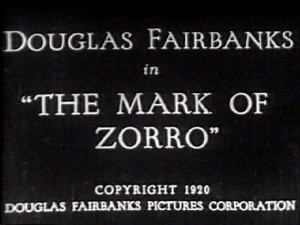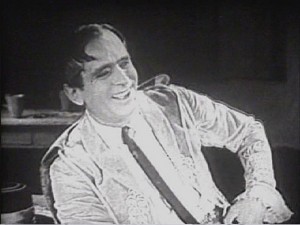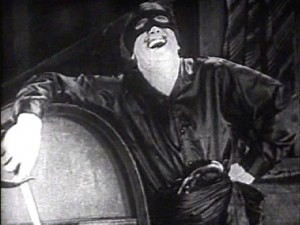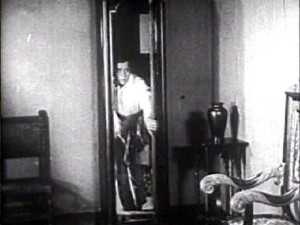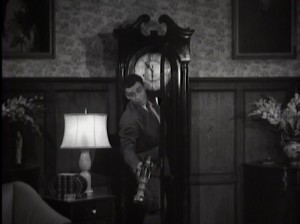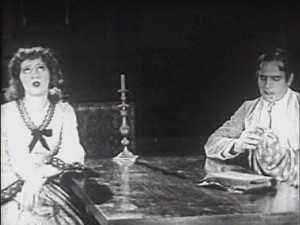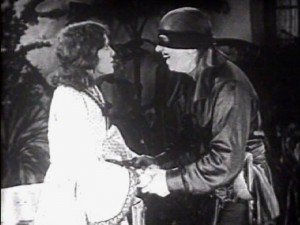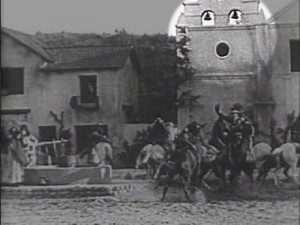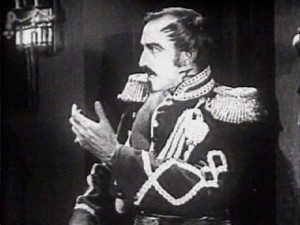Sorry for the late update. I was very busy last week, and it has been so ungodly hot that I literally couldn’t think at times. Digger World Headquarters is unfortunately not air conditioned.
Continuing our look back at properties that inspired some of today’s comic book heroes, we look at the first film appearance of Zorro, The Mark of Zorro, starring Douglas Fairbanks. The film was made by Fairbanks’s own company and was the first film released by United Artists, the distributor/independent studio formed by Fairbanks, Mary Pickford, Charlie Chaplin and D.W. Griffith.
Although Fairbanks is now mainly known as a silent-era swashbuckling action hero for his work in films like The Mark of Zorro, Robin Hood and The Thief of Baghdad, he started out as a star of romantic comedies. The Mark of Zorro was his first action role, although he didn’t give up comedy completely. He was like the silent era’s Bruce Willis.
The film tracks the plot of the original novel (published in All-Story Weekly the year before–come back Wednesday to learn more about it) fairly closely, although it does take some liberties. Nearly all the changes are improvements, though.
The film opens with the evil governor of California (back in the days when it was still a Spanish colony) vowing to put an end to the rebel Zorro once and for all. We learn that Zorro fights against tyranny and oppression and leaves his mark cut into the faces of evil men.
We are then introduced to dandy fop Don Diego Vega (Fairbanks), who recoils at tales of Zorro’s violence, but also enjoys a good laugh at the expense of boorish Sergeant Pedro Gonzales.
Fairbanks interpretation of Vega is strange. He is sometimes smiling and charming, projecting an air of harmlessness with Chaplinesque sight gags and sleight-of-hand tricks like pretending to drop his hat, only to catch it by its freakishly long chin strap. Other times, he tries to play Diego more like the book, as a listless fellow easily fatigued, which Fairbanks gives a slumping, sweaty stalker vibe.
As Sgt. Gonzales boasts about what he will do when he catches Senor Zorro (these early versions of the story always use the honorific–Senor Zorro), Vega takes his leave, and moments later, Zorro appears.
Hmmm, I wonder who that could be? Interesting trivia: Senor Zorro is the only character in the movie who smokes. The bad guys don’t smoke, only the good guy. Zorro humiliates Gonzales, then gives a rousing speech in favor of freedom from oppression and takes his leave when more folks show up.
Zorro eludes pursuit and returns home, where we learn that he is actually Don Diego Vega with a fake mustache. He has a secret room where he changes into his Zorro costume, entered by a fake grandfather clock.
Wow, that looks familiar…
Oh yeah, Batman originally entered the Batcave through a grandfather clock as well.
We also learn that his father wants him to get married to Senorita Lolita Pulido, daughter of a formerly rich local noble who has fallen into disfavor with the governor.
Vega goes out to see the Senorita, played by Marguerite de la Motte as a typical flighty silent film heroine with none of the fire of the novel’s character. But her blandness is offset by a couple of scenes where she expresses some very real disenchantment with her would-be suitor.
But not long after Don Diego Vega leaves without much romantic success, the girl is met in her garden by the dashing Zorro, although to be fair, I never thought Fairbanks was that handsome. He is athletic and graceful, but looks kind of weak-chinned and jowly in profile.
While her father summons the soldiers to come capture Zorro, Lolita falls in love with his charming ways. Their courtship is interrupted after the native servant arrives at the presidio to tell the soldiers that Zorro is in town. The presidio building is shocked at the news.
Zorro escapes and Lolita is smitten. But someone else has his sights set on the young maiden: Captain Ramon of the local presidio. His attempt at seduction fails, at which point it threatens to turn into an implied rape, when they are interrupted by the arrival of Senor Zorro.
Zorro and Ramon duel, and Zorro not only bests the captain, but cuts his mark into the captain’s neck, one tiny slash at a time.
Then he forces the captain to apologize to Lolita before throwing him out.
Later, Zorro whips a local magistrate who unjustly persecuted a friar on false charges. The local young nobles chase after Zorro and end up at the house of the senior Vega, where Zorro appears and convinces them to join his fight against injustice.
The opportunity does not take long to arrive. The governor arrives and is furious when he learns of the beating of the magistrate. Captain Ramon seizes the opportunity to take revenge on the Senorita by claiming that the Pulidos are in league with Zorro. The Pulidos are arrested and thrown in jail.
Zorro calls upon the other young nobles to aid him in a jailbreak, but Captain Ramon infiltrates the group and captures Lolita. Zorro manages to get her back, but then finds himself trapped in Don Diego’s house. He changes into his secret identity and confronts the governor and captain.
When Captain Ramon once again insults Lolita, Diego turns suddenly fierce and challenges the captain to a duel. He bests the captain, but his amazing skill with a sword reveals him to be Zorro! The gathered soldiers and nobles gasp. The governor wants him arrested, but the nobles, led by Don Alejandro Vega (greatly relieved to learn his son isn’t the useless fool he pretended to be), demand the governor cease his tyrannical ways and get his ass back to northern California where he belongs.
All ends well as Diego and Lolita kiss at last, although Lolita isn’t sure which guy she’ll actually be marrying.
All in all, the film works pretty well. Then ending is a bit underwhelming, but works better than the novel’s. In fact, the film overall is better structured than the novel. The film also establishes some key character hooks that later films would build on: the iconic costume (never described in much detail in the novel), the sleight-of-hand (which would become the cornerstone of Tyrone Power’s interpretation), Don Diego’s sojourn in Spain where he learned his skills, and the revelation of Don Diego Vega’s dual identity early rather than late (again, more about this when I discuss the novel on Wednesday).
And you can see the elements that would inspire the later Batman–the dark costume, the vigilante who fights for justice even against the  very police who supposedly stand for law and order, and the use of the weak public persona to divert suspicion (although Zorro cribbed this from the earlier Scarlet Pimpernel). Later writers have changed virtually every element of the plot, but the basic iconic elements have remained virtually unchanged. Antonio Banderas as Zorro is still recognizable as much the same character Fairbanks portrayed  in 1920.
The movie is in the public domain and can be watched free online here. Be here Wednesday to learn more about the novel that inspired it all, The Curse of Capistrano.


